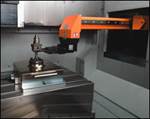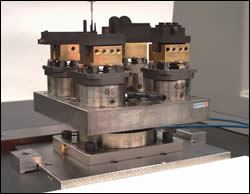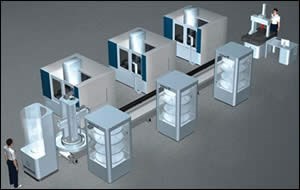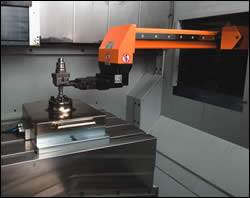Standardize Before You Automate
After standardization, automation will create the largest increase in profits that any one area can produce.
Today we are faced with rising labor costs, a shortage of skilled workers and ever-growing competition from low-wage countries; yet we still yearn for the one ingredient to separate ourselves from our competitors. This means we must change, but change does not have to be expensive or painful, it just has to be well-planned. Our true challenge is to figure out how to change, what to change and when to change. What is needed is a cohesive plan that does not attack only one area at a time, but looks at the overall process.
Employing value stream mapping and introducing true lean manufacturing is a first step with proven results. Although is it common to hear mold builders say that this cannot be done in the moldmaking industry, if these shops ignore that traditional thinking and evaluate their process, they will see positive change.
Standardize
To find the best process you must find the bottlenecks and move them to the beginning of the process. Now finding all the bottlenecks and addressing them appropriately is a challenge, but the answer is so simple: standardize all processes.
Approach every task, every job, every event the same way, every time that task, event or job type occurs. We have similar tasks even with different jobs, we machine things the same, we EDM the same, we use lifters, water lines, mill cavities, tap holes, polish, etc. We must standardize these processes even if what is being done during those events changes or appears to be different in concept.
This includes a standard way of engineering, workholding, manufacturing and shipping. With standard processes, it becomes easier to identify what areas are profitable and those that are not. You can look at the areas that have the most variables and make them less variable.
Fixturing/Worklholding
We know that fixturing/workholding is one of the biggest variables in every shop. The actual time used in just indicating and setting up a job is mind boggling. In a year that has 8,760 hours, we spend 2,200 hours on weekends, 1,160 hours for holidays and 3,600 hours on leisure time, sleep, meals, etc. The remaining 1,800 hours are for a single-shift of an eight-hour day.
The average single-shift operation on a machine with an operator only yields about 800 hours of true chip making. That leaves 1,000 hours of time that is used in the setup of that same machine. To take full advantage of those 1,000 hours seems to be the easiest and most logical approach to getting more production time. Using standardization as the driving principle on how to adjust a process, then standardizing how we hold onto the work should be a priority in eliminating this variable. In simple terms, reducing the time it takes on the average machine to do setups can almost double the true chip-making time of that machine.
Now if it was as simple as finding a way to fixture without indicating then the whole procedure would be easy. To find a process that is flexible enough to handle the variety of work, easy to implement and modular enough so it can grow as the needs grow, is not impossible, but not easy.
Many systems appear to have value, but have limitations that will not allow for future expansion and will limit the shop to their current investments. A true system will be modular in nature, which allows for expansion and automation. Using such a system you then need to move the thought process of workholding from the shop floor to the engineering department. Standardizing how to hold the work while using construction holes and special zero line centering is accomplished much more easily with the aids of solid models and CAD designs incorporated into the CAD library. Once you attack this tricky yet profitable area, it takes basic math to see how to get ahead.
In a single shift, if you eliminated 80 percent of the setup time, you would then gain another 800 hours of chip making, which would double your output to 1,600 hours. That alone can be the difference in some jobs from breaking even to being highly profitable.
By addressing workholding, you also are addressing the one area where most of the scrap is generated. An aerospace shop that standardized workholding saved $96,000.00 in one year from eliminating the scrapped and reworked parts. In a mold shop this would equate to delivering on time, getting paid faster, opening the shop for more work and keeping your valued customer.
The benefits to this simple process are endless. It lends itself to many other avenues—from more accurate quoting to shop layout, toolholders, programming systems and personnel. By standardizing you will create a system that allows for process control never before thought possible in a mold shop. Some shops have actually reduced their prices and increased their profits.
Automation
This is not all we need to do to be more competitive and to achieve our goals; it is only the beginning, but the actual investment to make these changes is minimal and uses existing machines and only requires some new fixtures.
Once standardization has taken place and work is flowing without any time wasted on setups, it will become clear what areas are the least profitable. One such area will be the work being loaded and unloaded from the machines in a manual fashion.
Using the premise of standardization, shops should develop a process that loads and unloads parts without using the highest skilled workers in the shop. It also is a waste of potential production time if a job or part is on one machine after it is completed while it waits for someone to remove it. The constant utilization of assets is critical to survival. Common sense would dictate that we remove the part as soon as the machine is done, and get the next job into the machine. This can be done with simple automation.
Automation seems to scare most shop owners and workers alike. What it does not do is replace workers. It allows for the skilled workers to do the tasks that they are trained to do and removes the mundane tasks.
The reason for automation seems to be the biggest stumbling block in the entire process, yet once you get passed that, the actual process is much easier. So, why should you automate? If we have achieved success in standardizing our workholding and increased our actual chip producing time from 800 to 1,600 hours a year, it’s time to see if we can capture more of the 7,000 remaining hours.
Many of you already use toolchangers for your cutters in your machining centers and electrode changers in your EDMs—that’s automation. Now you just need to move it into other areas; automation is just an extension of the standardization process. But remember, when investigating automation it is easy to over automate a process, so keep things simple and don’t lose sight of the goal.
After standardization, automation will create the largest increase in profits that any one area can produce. It is essential that you standardize first before you automate in order to achieve these results. If our competition is low-wage countries then the secret weapon we have been looking for is automation (see Sidebar).
Summary
Today there are advances that make the link between engineering and machining almost seamless and can be done in a virtual environment. All of these changes are incremental and create an environment that will place shops in the most competitive positions in the world economy. In upcoming issues, we will explore the proper ways to implement automation that fits each shop’s budget and process requirements.
Related Content
Maintaining a Wire EDM Machine
To achieve the ultimate capability and level of productivity from your wire EDM on a consistent, repeatable and reliable basis, regular maintenance is a required task.
Read MoreThe Benefits of Hand Scraping
Accuracy and flatness are two benefits of hand scraping that help improve machine loop stiffness, workpiece surface finish and component geometry.
Read MoreHands-on Workshop Teaches Mold Maintenance Process
Intensive workshop teaches the process of mold maintenance to help put an end to the firefighting culture of many toolrooms.
Read MoreRead Next
Automation and Moldmaking: Mold Production in Action
Moldmakers are starting to change the way they think and incorporate automation into all aspects of their operation—combining a multitude of processes in a single cell for optimal productivity.
Read MoreAre You a Moldmaker Considering 3D Printing? Consider the 3D Printing Workshop at NPE2024
Presentations will cover 3D printing for mold tooling, material innovation, product development, bridge production and full-scale, high-volume additive manufacturing.
Read MoreHow to Use Strategic Planning Tools, Data to Manage the Human Side of Business
Q&A with Marion Wells, MMT EAB member and founder of Human Asset Management.
Read More






















